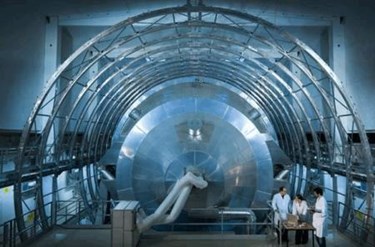KATRIN Spectrometer Experiment Attempts To Measure Precise Mass Of Neutrinos
By Jof Enriquez,
Follow me on Twitter @jofenriq

Physicists at the Karlsruhe Institute of Technology (KIT) in Germany have switched on a 220-ton, 60 million euro ($66 million) apparatus that will attempt in the next five years to pin down the absolute mass of neutrinos – the so-called ghost particles of cosmology believed to hold vital clues to the origin and fate of the universe.
The Standard Model of particle physics long has considered neutrinos as massless. But this belief was upended when 2015 Nobel Prize winning-experiments by Takaaki Kajita and Arthur B. McDonald demonstrated that neutrinos do have a small but finite mass, because neutrinos from the Sun and the Earth's atmosphere "change identities" on their way to the Super-Kamiokande detector and the Sudbury Neutrino Observatory. With this breakthrough discovery, further experiments around the world are underway to capture and understand these mysterious particles.
One of these endeavors, the KArlsruhe TRItium Neutrino (KATRIN) experiment at KIT, just began operating a massive yet very precise spectrometer to measure the energy of electrons during decay of the radioactive hydrogen isotope tritium.
According to Deutsche Welle (DW), "the KATRIN facility consists of a room in which beta decay takes place. The neutrinos disappear somewhere - anywhere. What's left are electrically charged electrons, which can be steered into a specific direction by a magnetic field: Through a spectrometer to a detector. The spectrometer decelerates the electrons using an electrostatic field, so that only a few of the electrons will make it to the detector. By controlling the strength of the field, the physicists can now evaluate the energy of the passing electrons - and that means their mass.”
Basically, if you deduct the mass of the emitted electron (about 511 kilo-electron-volts, or eV) from the mass of the original atom, you will get the mass of the neutrino, which is about 250,000 times lighter than an electron.
"Predecessor experiments at Mainz and Troitsk were able to appoint an upper limit to the electron anti-neutrino mass of 2.3 eV/c2," states the KATRIN experiment web page. "KATRIN, using the same measurement technique, will either improve this limit by one order of magnitude, down to 0.2 eV/c2 (90% CL), or discover the actual mass, if it is larger than 0.35 eV/c2. This requires an improvement by two orders of magnitude with respect to key experimental parameters."
Basic specifications and measurements of the KATRIN experiment apparatus are discussed in a paper by Susanne Mertens of the Lawrence Berkeley National Laboratory, for the KATRIN Collaboration, which consists of 150 scientists, engineers, technicians and students from 12 institutions in Europe and the United States.
Other major neutrino projects include: the Oscillation Project with Emulsion-tRacking Apparatus (OPERA), linked from particle accelerators and detectors at CERN, the European Organization for Nuclear Research; the IceCube South Pole Neutrino Observatory in Antarctica; the U.S. Department of Energy’s SLAC National Accelerator Laboratory, and the Deep Underground Neutrino Experiment (DUNE) at the planned Long-Baseline Neutrino Facility (LBNF) – the world's flagship neutrino experiment for the coming decade and beyond. These projects also seek to study other exotic sub-atomic particles that lead to understanding dark matter - perhaps the biggest mystery in the universe.
